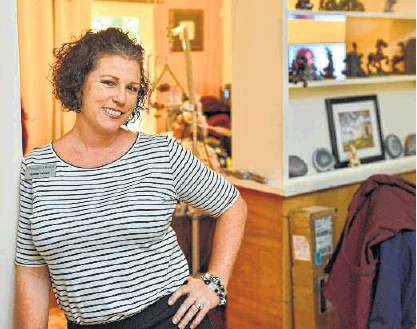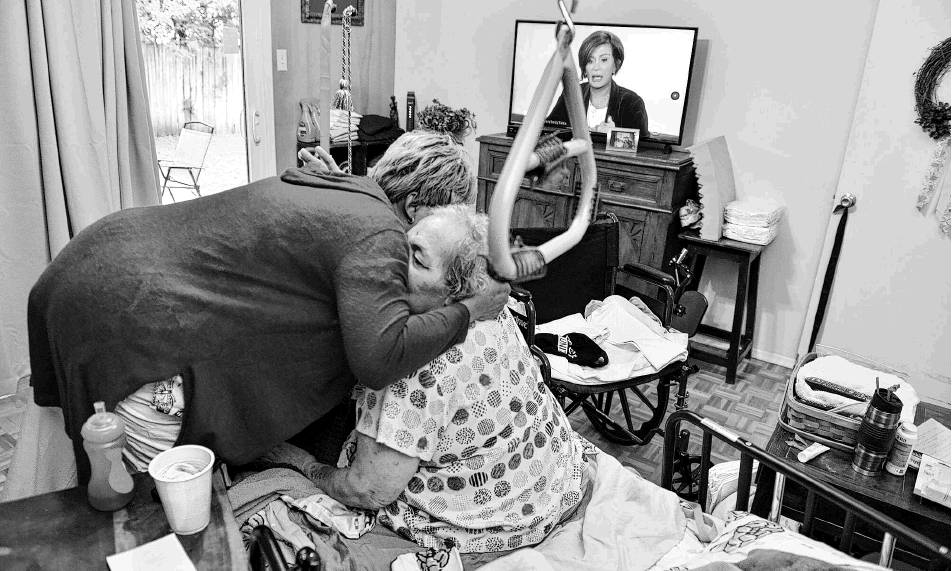HOME HEALTH CARE
PERSONAL HEALTH CARE FOR ELDERLY
Right at Home helps clients remain independent
By Lynn Brezosky STAFF WRITER
It started out as a simple fracture, a cracked bone at the knee joint. The screws that her doctor put in held for a while, but then one day Jamie Snyder’s leg bowed out. Her subsequent knee replacement was a success — until an infection set in.
“I noticed a little pimple on my leg that turned into a big boil,” said Snyder, 66, a former Air Force nurse. “And we don’t know where it came from, how it got there.”
A visiting wound care nurse keeps an eye on the infection, and a physical therapist helps Snyder toward her goal of walking and driving again. And three days a week, home health aide Barbara Stephen helps Snyder with more mundane tasks: driving her to doctor appointments and the grocery store, changing her bedding, cooking meals, and checking on her beloved cat and dog.
Stephen’s regular visits allow Snyder to live independently in her Northeast Side home, rather than at the rehabilitation facility where she spent time after her last trip to the hospital. It’s a form of support that more and more Americans are coming to depend on as the population ages. Snyder’s sister lives across the street but can help only so much because she has a full-time job of her own.
“It took a lot off of me to be able to come home and make sure my pets were OK, more than anything else,” Snyder said the other day as her small dog, Chester, leaped onto her bed. “Plus, to tell you the truth, the longer I stayed where I was, the more I was more afraid of getting re-infected.”
“You have to care for others. You can’t just look at it as, ‘I’m just getting a paycheck.’ ”
Sloane Wendell, owner of Right at Home, a home health care franchise
Snyder is a client of Right at Home, a home health care agency that works through local franchises to connect caregivers with clients needing companionship, help with everyday chores or assistance coping with serious conditions such as advanced Parkinson’s disease or Alzheimer’s.
Right at Home, founded by a former hospital administrator and based in Omaha, Neb., directly employs caregivers and matches them to clients. It now has more than 500 franchises across the U.S. and internationally.
Sloane Wendell took over the San Antonio franchise about a year ago, parlaying decades in corporate management and 15 years of experience caring for her aging grandparents into a piece of a $103 billion industry that’s expected to grow to nearly $173 billion by 2026. Her roster of employees has expanded to 55, a 30 percent increase.
Wendell expects the holiday season to be a busy time.
“A lot of people come home and see their mom and dad, aunts and uncles, who maybe they haven’t seen since last Thanksgiving, and they’ve regressed a lot,” she said. “And they’re like, ‘Oh my gosh, we need to get them some help.’”
Home health care is one of the nation’s fastest growing occupations. According to the Home Care Association of America, it employs 1.8 million people and is expected to grow 28 percent through 2024, compared to 6.5 percent for all other occupations.
Sixty million Americans are expected to enter the 65-and-older bracket by 2020. By 2050, 19 million Americans will be over 85.
Seventy percent of those 65 and older will need assistance at some point, and 40 percent will need help daily, according to the Home Care Association, which represents providers of nonmedical, private-duty home care.
Nine out of 10 elderly Americans say they want to live at home as long as possible. But the pool of adult children, the traditional base of home care, is shrinking.
“There’s going to be a whole lot more older people and a lot fewer younger people,” said Mike Flair, vice president of franchise business solutions for Right at Home. “It’s kind of staggering to think what’s driving this, and it comes down to people just had fewer kids and now it’s catching up with us.”
Texas has nearly 6,000 licensed home care agencies, said Becky Campbell, director of membership recruitment for the Texas Association for Home Care & Hospice, a trade organization.
Despite the growing demand for service, the pay is low. The median wage for home health and personal care aides in 2017 was $11.12 an hour, or $23,130 per year, according to the federal Bureau of Labor Statistics. By comparison, the median annual salary in the U.S. was $44,564.
Nonmedical care such as that provided by Right at Home is usually not covered by insurance. It’s a “private-duty” service, provided outside the government safety net, and clients or their families shoulder the cost. That puts a damper on wages.
Agencies do offer workers’ compensation insurance and deduct payroll taxes from caregivers’ wages. They also carry insurance to protect clients against liability in case a caregiver is injured on the job.
Rates run $20 to $30 an hour, meaning that a single three-hour appointment can set a family back as much as $90.
“Insurance doesn’t pay for this,” Flair said. “There’s some government assistance if you’re a veteran, but typically this is what we call private pay.”
“We have some clients that we’re with literally seven days a week, so it can add up for a family to be able to afford to take care of Mom, to keep her independent in her home, especially when those children have moved away,” he said.
The industry is trying to improve its image. Right at Home declared Nov. 12 to 18 “Professional Caregivers Week” and says it wants competitors to join a national conversation “to celebrate our personal caregivers.”
“People typically think they’re not educated, they’re not trained, they’re sort of classified as maybe a minimum-wage-type position,” Flair said. “That’s unfortunately a stereotype we’re trying to break.”
“This is more than just a nanny to a granny,” he said, noting that caregivers included retired teachers and nurses as well as stay-at-home mothers looking to work part-time. “Our caregivers are trained. They’re insured. They’re actual employees. They’re supervised, and they deserve to be respected.”
Wendell, now 41, said she got into the business looking for personal fulfillment.
“I decided I didn’t want to be in corporate America any more. I was working 80 hours a week, and I’d kind of hit a glass ceiling,” she said. “I sat down and kind of reflected, did some soul-searching, and just thought about all the rewards that I had gotten from taking care of my grandparents. And I also looked at where the markets were going and where business was growing, and I thought this was a great place to go.”
She also liked the franchise model. Technology has helped agencies like Right at Home balance the needs and personalities of caregivers and clients. A smart-phone app tracks when caregivers are on location and allows them to call up the day’s treatment plan for a particular client.
Since Wendell has a pool of employees, she can find substitutes if a caregiver calls in sick. And clients’ families, she said, can enjoy peace of mind knowing the agency is state-certified and has thoroughly vetted every employee.
But recruitment is a constant challenge, she said. Home health care workers do not need extensive education — some are certified nursing assistants, medical assistants or licensed vocational nurses. But it takes a certain type of person to succeed in the job, Wendell said.
“You have to care for others,” she said. “You can’t just look at it as, ‘I’m just getting a paycheck.’ Those people don’t stay, and they don’t work out.”
Which may be why Stephen, Snyder’s caregiver, has been at it more than 20 years.
“I have a passion for it. I wouldn’t be here if I didn’t have a passion for it,” she said, leaving Synder with an “I love you” and a good-bye hug.



